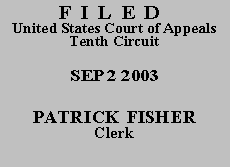

Plaintiff-Appellee,
v.
ROBERT VERBICKAS,
Defendant-Appellant.
Plaintiff-Appellee,
v.
ROD SCHULTZ,
Defendant-Appellant.
Plaintiff-Appellee,
v.
MIKE LAVALLEE,
Defendant-Appellant.
Defendants were three of seven federal correctional officers charged in a superseding indictment with ten counts of violating the civil rights of inmates incarcerated in the United States Penitentiary at Florence, Colorado. These three defendants were each convicted by a jury of one count charging a substantive offense under 18 U.S.C. § 242, and defendants Schultz and La Vallee were also convicted of one count charging conspiracy in violation of 18 U.S.C. § 241. Defendants were found "not guilty" on all other counts.
The district court determined that § 242 is a "crime of violence" within the meaning of 18 U.S.C. § 3156(a)(4)(B), triggering for all three defendants the mandatory detention provision in 18 U.S.C. § 3143(a)(2), read in conjunction with 18 U.S.C. § 3142(f)(1). The court further determined that defendants did not show that they were substantially likely to succeed on a motion for acquittal or for a new trial to meet the exception to detention in § 3143(a)(2)(A)(i), and did not show exceptional reasons why they nevertheless should not be detained to meet the exception in § 3145(c).
On appeal, defendants argue that a charge under § 242 does not, by its nature, pose a substantial risk of physical force and, so, is not a "crime of violence" as defined in § 3156(a)(4)(B). In addition, they assert that they showed the following exceptional reasons why they should not be detained under § 3145(c): (1) the jury returned sixteen "not guilty" verdicts on counts charging excessive force, including some "not guilty" verdicts as to these defendants; (2) the Mandatory Detention Act does not define the critical terms "crime of violence" and "exceptional reasons"; (3) there was disparate treatment between these defendants, who were ordered detained, and other defendants who pleaded guilty to charges under § 242 and who were not detained pending sentencing; (4) the trial court's application of the Mandatory Detention Act to these defendants was unconstitutional; (5) the jury returned a statement that the climate of abuse at Florence should be taken into account when defendants are sentenced; and (6) defendants had no prior record and showed exemplary conduct since they were charged.
The question whether a charge under § 242 constitutes a "crime of violence" under § 3156(a)(4)(B) is a legal question that we review de novo. See United States v. Vigil, 334 F.3d 1215, 1218 (10th Cir. 2003) (considering similar definition of "crime of violence" under USSG § 4B1.2). We also review de novo the determination that defendants showed no exceptional reasons why they nevertheless should not be detained under § 3145(c). United States v. Kinslow, 105 F.3d 555, 557 (10th Cir. 1997).
Under § 3156(a)(4)(B), an offense is a "crime of violence" if it is a felony and, "by its nature, involves a substantial risk that physical force against the person or property of another may be used in the course of committing the offense." When we determine the nature of the offense under § 242 charged against these defendants, we consider only the statutory elements of the offense and not the evidence adduced at trial. See United States v. Zamora, 222 F.3d 756, 764 (10th Cir. 2000) (considering definition of "crime of violence" under USSG § 4B1.2); United States v. Reyes-Castro, 13 F.3d 377, 379 (10th Cir. 1993) (considering definition of "crime of violence" under 18 U.S.C. § 16 identical to that under § 3156(a)(4)). If there is any ambiguity, we may "look beyond the statute to certain records . . ., such as the charging documents, the judgment, any plea thereto, and findings by the court." Zamora, 222 F.3d at 764.
In light of the Supreme Court's decision in Apprendi v. New Jersey, 530 U.S. 466 (2000), the three clauses of § 242 define separate offenses with different elements. United States v. Williams, No. 02-60519, 2003 WL 21940787, at *5 (5th Cir. Aug. 14, 2003). Defendants concede that they were charged with violating the offense defined by the second clause, that is, with violating inmates' constitutional rights in a manner that resulted in bodily injury. Aplt. Verbickas' Br. at 6. We have no trouble concluding that the offense defined by § 242 that includes the element of bodily injury involves a substantial risk that physical force will be used in the commission of the offense, and is therefore a "crime of violence" under § 3156(a)(4)(B). Accord Williams, 2003 WL 21940787, at *4 (considering identical definition for "crime of violence" under 18 U.S.C. § 924(c)(3)(B)). Defendants' argument that not all scenarios that result in bodily injury include a risk of physical force violates the requirement that we examine the nature of the offense in the abstract, and not the theoretical possibilities of individual cases. See Zamora, 222 F.3d at 764-65. We hold that the district court did not err in concluding that defendants' convictions under § 242 triggered the mandatory detention provision in § 3143(a)(2), read in conjunction with § 3142(f)(1).
We also agree with the district court that defendants failed to show exceptional reasons that they nevertheless should not be detained under § 3145(c). Included among defendants' arguments to support exceptional reasons which would justify their release is the argument that other defendants convicted of § 242 violations were released. This disparate treatment argument does not establish an exceptional reason warranting defendants' release. Whether the court erred in the release of other defendants does not provide a basis for release of these defendants, or result in our concluding that the detention of the defendants is unconstitutional.
The judgment of the district court is AFFIRMED.
ENTERED FOR THE COURT
PER CURIAM
*. This order and judgment is not binding precedent, except under the doctrines of law of the case, res judicata, and collateral estoppel. The court generally disfavors the citation of orders and judgments; nevertheless, an order and judgment may be cited under the terms and conditions of 10th Cir. R. 36.3.